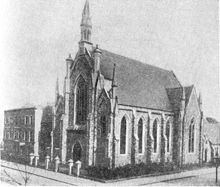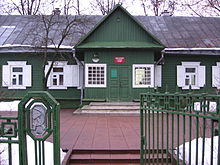- This article deals with the political organisation established in 1883 and its history until the final split in 1912.
The Russian Social Democratic Labour Party (Russian РоÑÑиÌйÑÐºÐ°Ñ ÑоциаÌл-демократиÌчеÑÐºÐ°Ñ Ñ€Ð°Ð±Ð¾ÌÑ‡Ð°Ñ Ð¿Ð°ÌртиÑ, РСÐ"РП, Rossiyskaya sotsial-demokraticheskaya rabochaya partiya, RSDRP), also known as the Russian Social Democratic Workers' Party or the Russian Social Democratic Party, was a revolutionary socialist political party formed in 1898 in Minsk to unite the various revolutionary organisations of the Russian Empire into one party. The RSDLP later split into Majority and Minority factions, with the Majority (in Russian: "Bolshevik") faction eventually becoming the Communist Party of the Soviet Union. The Interdistrictites were also formed from this party.
In Russia proper

The RSDLP was not the first Russian Marxist group; the Emancipation of Labour group was formed in 1883. The RSDLP was created to oppose narodnichestvo, revolutionary populism, which was later represented by the Socialist-Revolutionary Party (SRs). The RSDLP program was based on the theories of Karl Marx and Friedrich Engels - that, despite Russia's agrarian nature, the true revolutionary potential lay with the industrial working class. The RSDLP was illegal for most of its existence; at the end of the first party congress in March 1898, all nine delegates were arrested by the Imperial Russian Police. At this time there were 3 million Russian industrial workers, just 3% of the population.
Before the Second Congress, a young intellectual named Vladimir Ilyich Ulyanov joined the party, better known by his pseudonymâ€"Vladimir Lenin. In 1902 he had published What is to be Done?, outlining his view of the party's task and methodologyâ€"to form "the vanguard of the proletariat." He advocated a disciplined, centralised party of committed activists.
In 1903, the Second Congress of the party met in exile in Brussels to attempt to create a united force. However, after unprecedented attention from the Belgian authorities the congress moved to London, meeting on August 11 in a chapel in Tottenham Court Road. At the congress, the party split into two irreconcilable factions on November 17: the Bolsheviks (derived from "Bolshinstvo"â€"Russian for "majority"), headed by Lenin, and the Mensheviks (from "Menshinstvo"â€"Russian for "minority"), headed by Julius Martov. Confusingly, the Mensheviks were actually the larger faction, however the names Menshevik and Bolshevik were taken from a vote held at the 1903 party congress for the editorial board of the party newspaper, Iskra ("Spark"), with the Bolsheviks being the majority and the Mensheviks being the minority. These were the names used by the factions for the rest of the party congress and these are the names retained after the split at the 1903 congress. Lenin's faction later ended up in the minority and remained smaller than the Mensheviks until the Russian Revolution of 1917.
A central issue at the congress was the question of the definition of party membership. Martov proposed the formulation "A member of the Russian Social-Democratic Labour Party is one who accepts the Party’s programme, supports the Party financially, and renders it regular personal assistance under the direction of one of its organisations." Lenin, on the other hand, proposed a more strict definition: “A member of the Russian Social-Democratic Labour Party is one who accepts its programme and who supports the Party both financially and by personal participation in one of the Party organisations." Martov won the vote, and the bolsheviks accepted it as part of the adopted organisational rules.
Despite a number of attempts at reunification, the split proved permanent. As time passed, more ideological differences emerged. According to many historians, the Bolsheviks pushed for an almost immediate "proletarian" revolution, while the Mensheviks believed that Russia was still at too early a stage in history for an immediate working-class revolution. The two warring factions both agreed that the coming revolution would primarily be "bourgeois democratic" in its character. But while the mensheviks viewed the liberals as the main ally, the bolsheviks opted for an alliance with the peasantry as the only way to carry out a popular revolution while defending the interests of the working class. Essentially, the difference was that the bolsheviks considered that in Russia, the tasks of the bourgeois democratic revolution would have to be carried out without the participation of the bourgeoisie.
The Third Congress of the party (1905) was held separately by the Bolsheviks. The Fourth Congress (1906) was held in Stockholm, Sweden and saw a formal reunification of the two factions, (with the Mensheviks in the majority), but the discrepancies between Bolshevik and Menshevik views became particularly clear during the proceedings.
The Fifth Congress of the party was held in London, England, in 1907; it consolidated the supremacy of the Bolshevik faction and debated strategy for communist revolution in Russia. Stalin never later referred to his stay in London.
The Social Democrats (SDs) boycotted elections to the First Duma (Aprilâ€"July 1906), but were represented in the Second Duma (Februaryâ€"June 1907). With the SRs, they held 83 seats. The Second Duma was dissolved on the pretext of the discovery of an SD conspiracy to subvert the army. Under new electoral laws, the SD presence in the Third Duma (1907â€"12) was reduced to 19. From the Fourth Duma (1912â€"17), the SDs were finally and fully split. The Mensheviks had five members in the Duma and the Bolsheviks had seven, including Roman Malinovsky, who was later uncovered as an Okhrana agent. From 1912 onwards, the Bolshevik faction was officially a separate party, known as the Russian Social Democratic Labour Party (bolshevik). The Bolsheviks seized power during the October Revolution in 1917 and, in 1918, changed their name to the (All-) Russian Communist Party. They banned the Mensheviks after the Kronstadt Uprising of 1921.
In Estonia

In 1902 the Tallinn organisation of the RSDLP was founded, which in 1904 was converted into the Tallinn Committee of the party. In November a parallel (that is, also directly under the CC of RSDLP) Narva Committee was created. Amongst other radicals, the Estonian RSDLP cadres were active in the 1905 revolution.
At the conference of the Estonian RSDLP organisations in Terijoki, Finland in March 1907 the Bolshevik supporters came into serious conflict with the Mensheviks.
In Latvia
At the Fourth (Unity) Congress of the RSDLP in 1906, the Latvian Social Democratic Workers Party entered the RSDLP as a territorial organisation. After the congress its name was changed 'Social-Democracy of the Latvian Territory'.
Footnotes

See also
- Factions of the RSDLP
- Socialist-Revolutionary Party